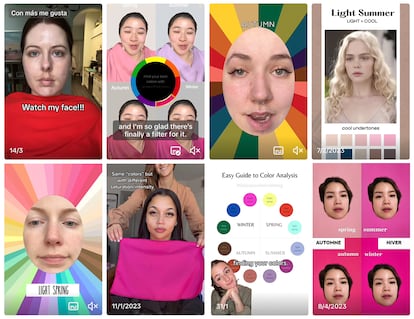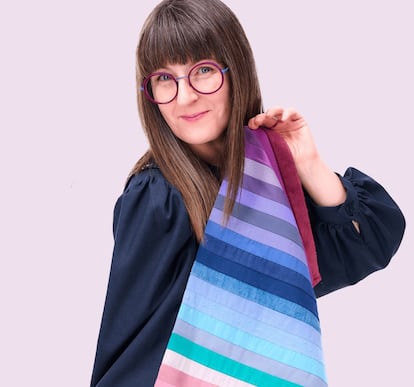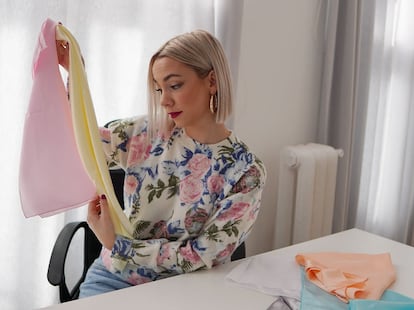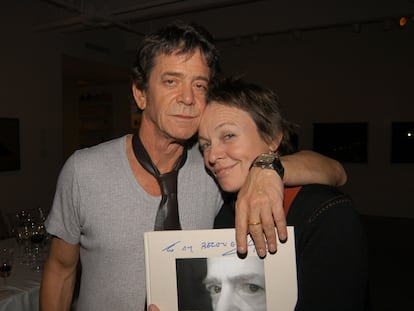Learning what colors suit you: How a business has been revived thanks to social media
A discipline that examines skin, eye and hair tones to prescribe the ideal wardrobe, color analysis is experiencing a boom thanks to new market opportunities emerging on digital platforms, particularly TikTok


“Winter, summer, spring, or fall — who’s the fairest of them all?” That’s the big question from the 1981 book Color Me Beautiful by Carole Jackson. In a little over 200 pages, the author explains how a person should choose the clothes they wear according to their skin, hair, and eye color, for which she defined four “seasons” and 16 color subgroups. A summer girl should use radiant colors to highlight her features, and a winter girl should opt for muted and dramatic tones. This discipline, known as color analysis or skin-tone analysis, has burst onto social media, after years as a niche interest, and has created a booming market thanks to the new ways of doing business offered by platforms such as TikTok. The emergence of artificial intelligence in fields such as fashion and personal image has also opened a wealth of opportunities.
Coffee shops, jewelry stores, candy stands, real estate agencies, and lawyers are among the growing number of companies, small businesses, and professionals who have turned TikTok into a window for their services or into a business in itself. The phenomenon has been extraordinarily driven by the so-called generation Z — born between 1997 and 2012 — who are the ones who, above all, drive, consume, and revive fashions and businesses on the platform. Over 50% of generation Z use the platform, according to the study What Business Needs To Know About The Generation Changing Everything, published by the consulting firm Oliver Wyman last year. The report also shows that this generation is four times more likely to find products and services through online searches or directly on social media, than through the traditional method.
@carolbrailey The reds, pinks and purples in each colour analysis palette… it’s a Valentine’s Day special post 💕 I always include purple in colours of love because magenta and purples are fabulous colours in terms of colour energy to connect us with highest love, spiritual-based love. I wish you a day filled with unconditional love 💕🎨⭐️ #carolbrailey #coloranalysis #colouranalysis #colouranalysistok #coloranalysistok #undertone #sparkle #authenticity #naturalbeauty #personalcoloranalysis #personalcolouranalysis #colourseasons #colorseasons #valentinesday
♬ original sound - Carol Brailey|Color Analysis🎨
A little over a year ago, color analysis joined this flurry of new business niches that are flourishing on TikTok. In countries like South Korea, color analysis has been around for decades, and the country has even become a destination for tourists who travel to have their colors analyzed by top-level analysts at luxury prices, but the phenomenon has grown after going viral on TikTok. According to a report by Business Insider, many foreigners travel to Seoul every year and spend hundreds or even thousands of dollars for the most sought-after color analysis services in that country.
If you search for “color analysis” on TikTok, you get tens of thousands of results ― some with millions of views ― mainly from young women explaining how to correctly find the colors of clothing that suit their skin tone. But beyond being a viral trend, color analysis is also a growing market, with more and more image consultants selling their services online to perform a professional analysis and thus help their clients choose their ideal wardrobe and makeup.
From in-person service to online triumph
Carol Brailey is one of them and a veteran of color analysis. Her journey began in the early 2000s, when she took a personal image course at George Brown University in Toronto. “In a few months I realized that it was my passion,” she explains in a video call. She continued her training at the International Image Institute (also in Canada), and since then she has been completely immersed in this world. She previously offered in-person color analysis, along with other types of advice, but now she deals exclusively in online color analysis services, for which she charges $300 Canadian (about $220 U.S.).
Brailey maintains that color analysis predates the publication of Color Me Beautiful by many years. According to the expert, the great pioneer of this field was the Swiss painter Johannes Itten, who at the beginning of the 20th century realized that the portraits his students painted looked better when the colors of the objects “harmonized” with those of the sitters’ skin. Furthermore, it was Itten who established the division of colors by seasons.

For Brailey, color analysis has existed since then, and she does not agree with the notion that it has made a comeback: “It never disappeared, but I think that now social media has given it a lot of visibility.” She does clarify, however, that over the decades it has evolved. For example, she works with 22 color categories and not the 16 that Color Me Beautiful describes. Brailey explains that the subdivisions depend on the system being used, since a category such as autumn can be divided into more categories, such as “warm autumn” or “temperate autumn,” depending on the analyst.
For an online color analysis, consultants usually request photos or videos of the client with a neutral background and without makeup, in order to observe the client’s natural colors, diagnose a category, and recommend the shades that will highlight their features.
This is how Brailey and other advisors work. One of these is Marcelle Kozlowski, a Brazilian lawyer who lives in New York and who a few years ago found a new career in color analysis. It all started, she says, by helping other people get dressed for important appointments like job interviews or meetings. “Let’s say that my client is a CEO, and she is having a hard time presenting herself as such to her colleagues. They don’t see her as a boss because she wears very pale colors and can’t communicate what she wants. That’s why, when people contact me, I ask them what they are looking to project, and I help them find the colors for them,” she says via video call.
A booming trend
María García from Albacete, Spain, is an image consultant who started her own company in February 2023. Although her services are not only color analysis, it is one of the pillars of her work. As she explained by email, for the sum of €60 ($63) she sends the client a “questionnaire” to find out details that cannot be learned from images alone and subsequently requests a series of photographs where the skin, hair, and eyes can be seen. “From there I carry out different color tests and based on those and the client’s features, I determine the color analysis,” she explains.
According to TIME magazine, prices for color analysis in the United States are usually close to $500, while in South Korea (a country where color analysis is a big deal) these range between $60 and $180. An internet search shows that in Spain clients can have their colors analysed for a little more than $100.
The internet and social media allow us to see the varied range of color analysis services that are currently on offer. And it is true that, as Brailey explains, it is not something new. The American historian Nicole Rudolph explains in a YouTube video with newspaper clippings from the time that since the 1980s color analyses in the U.S. were already being offered for prices ranging from $35 to $300, without adjusting for current inflation.
@color.analysis 🌈✨ ever wondered if the colors in your wardrobe are truly speaking to you? to those scrolling through, have you ever questioned the impact of hues on your personal narrative? your wardrobe is your canvas, and each color is a brushstroke telling the world your unique narrative. imagine a life without the vibrant spectrum that colors provide – it’s like a story with missing chapters. can you dress monochrome? yes, of course! but make this decision consciously of the message that you want to convey! or do you think i chose gray for this video by chance? 🤔 watch the video carefully! 🎨 join me on this colorful journey and discover the transformative power of personal expression. 🌈 as an image consultant specializing not only in colors but also in online sessions, i offer a unique perspective on crafting your story. 🖌️💬 ❤️ follow for more insights into smart personal image – because on instagram, every follow is a vote for a vibrant, personalized world! 🌐❤️✨ #colorfullife #imageconsultant #personalstyle #coloranalysis #onlinecoloranalysis
♬ Natural Emotions - Muspace Lofi
Mostly women and mostly white people
When talking about color analysis, it is common to do so in feminine terms. This is not a prejudice, since the experts who were consulted confirm that only a minority of men seek a color analysis. Carol Brailey estimates that men make up 20% of her clientele, and Marcelle Kozlowski says that more and more are interested in color analysis. María García, however, says that for the moment she has only worked with women.
Another issue that constantly arises in the history of this business is whether it is a service suitable for non-white people. “Color me Beautiful was written for an audience of white women, and to the extent that it attempted to include other women, the book divided ethnic groups with seasons. It said that ‘Blacks, Italians, and Jews are Winters,’” reads an article in Jezebel magazine that refers to how Carole Jackson’s book tried to appease criticism of racism by including non-white women in later editions.
All the experts consulted by EL PAÍS strongly reject this criticism. They claim that they serve a diverse clientele and that color analysis can be applied to anyone regardless of their skin color or any other characteristic of their body.

Color analysts also agree that while social media have been a great tool to get themselves known, they have also spread a lot of inaccurate information about what color analysis involves. A practice that constantly appears in searches on TikTok and Instagram, and that they consider does not work, is observing the veins in people’s wrists to determine “the undertones” of the skin color and applying them in the color prescription.
TikTok has also been filled with thousands of videos in which young women use filters that supposedly determine their color season, but many appear to be random results because they can prescribe different seasons one after another to the same person. Reproductions and likes, however, have contributed to cementing the place of color analysis on the platform. ChatGPT is also no stranger to color analysis and is capable of diagnosing a color season if supplied with a description of a person’s skin tone and eye color.
AI boost
This new boom in color analysis has also allowed it to merge with technological advances, such as artificial intelligence (AI). In Málaga (Spain), a company called ColorAI was launched three months ago. It developed color analysis software that it sells to cosmetics and clothing companies and beauty salons. The co-founder and executive director, Estefanía Moreno, says via video call that she has always been “passionate about the world of personal image.” She says that is why she specialized in color analysis in Brazil with Luciana Ulrich, an important figure in this discipline. Back in Spain, Moreno decided she wanted to take her color analysis work a step further.
The ColorAI application uses an artificial intelligence algorithm. According to the co-founder, the application is available for a subscription of €60 (around $65) aimed exclusively at companies. “When a salon hires us, we create a user and they install the application on a tablet, a smartphone, or a smart mirror. Then the client stands in front of the device, it takes a photograph, and that’s when the artificial intelligence analyzes the pigments,” she explains. In salons, the application will recommend haircuts “according to your face type” and the colors “that best suit you. You are also given your color palette for clothing, and it shows you your makeup colors,” explains Moreno.

At the moment, the co-founder says she cannot comment on the companies they are negotiating with, but she says that at ColorAI they are “very happy with the positive reception and interest from brands.”
From Johannes Itten’s painting classes to artificial intelligence applications, passing through Color Me Beautiful, color analysis has established itself in popular culture and as a form of business. Historian Nicole Rudolph, however, believes there are problems in this field that persist today. “It is not a perfect system. Two different analysts can assign you different color seasons,” she says in a video in which she highlights alleged inaccuracies in the season categories that, according to her, omit essential aspects such as color contrast. She also mentions how color analysis is still pigeonholed as a discipline for people with light skin: “It is designed to work on a very limited range of skin tones, particularly light tones.”
Sustainable fashion influencer Verena Erin is also critical and maintains that the only filter to apply when dressing is “what you like and what you feel best in. At the end of the day, color analysis is just a random person’s opinion on what they think looks good on you,” she says via email.
Sign up for our weekly newsletter to get more English-language news coverage from EL PAÍS USA Edition
Tu suscripción se está usando en otro dispositivo
¿Quieres añadir otro usuario a tu suscripción?
Si continúas leyendo en este dispositivo, no se podrá leer en el otro.
FlechaTu suscripción se está usando en otro dispositivo y solo puedes acceder a EL PAÍS desde un dispositivo a la vez.
Si quieres compartir tu cuenta, cambia tu suscripción a la modalidad Premium, así podrás añadir otro usuario. Cada uno accederá con su propia cuenta de email, lo que os permitirá personalizar vuestra experiencia en EL PAÍS.
¿Tienes una suscripción de empresa? Accede aquí para contratar más cuentas.
En el caso de no saber quién está usando tu cuenta, te recomendamos cambiar tu contraseña aquí.
Si decides continuar compartiendo tu cuenta, este mensaje se mostrará en tu dispositivo y en el de la otra persona que está usando tu cuenta de forma indefinida, afectando a tu experiencia de lectura. Puedes consultar aquí los términos y condiciones de la suscripción digital.
More information
Archived In
Últimas noticias
Most viewed
- Sinaloa Cartel war is taking its toll on Los Chapitos
- Oona Chaplin: ‘I told James Cameron that I was living in a treehouse and starting a permaculture project with a friend’
- Reinhard Genzel, Nobel laureate in physics: ‘One-minute videos will never give you the truth’
- Why the price of coffee has skyrocketed: from Brazilian plantations to specialty coffee houses
- Silver prices are going crazy: This is what’s fueling the rally










































